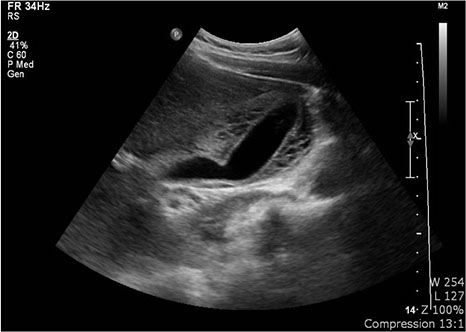Korean J Pediatr Infect Dis.
2012 Dec;19(3):157-161.
Acute Acalculous Cholecystitis with Bacteremia Caused by Streptococcus anginosus Following Dental Procedure in a Previously Healthy Adolescent
- Affiliations
-
- 1Department of Pediatrics, College of Medicine, The Catholic University of Korea, Seoul, Korea. kjhan@catholic.ac.kr
- 2Department of Pediatrics, College of Medicine, Korea University, Seoul, Korea.
Abstract
- Streptococcus anginosus is a member of Streptococcus milleri group, and is found in the oral mucosa, respiratory tract, and gastrointestinal tract as normal flora. It can develop into a disease in patients with deteriorating clinical condition or with clinical risk factors. A previously healthy 15-year-old boy was admitted due to fever, abdominal discomfort and vomiting which lasted for 7 days. He had a history of dental procedure 1 day before the development of fever. He was diagnosed with acute acalculous cholecystitis based on the clinical, laboratory, and imaging finding, and S. anginosus was isolated from the blood culture. The patient was successfully treated with antibiotic therapy.
Keyword
MeSH Terms
Figure
Reference
-
1. Ruoff KL. Streptococcus anginosus ("Streptococcus milleri"): the unrecognized pathogen. Clin Microbiol Rev. 1988. 1:102–108.
Article2. Claridge JE 3rd, Attorri S, Musher DM, Hebert J, Dunbar S. Streptococcus intermedius, Streptococcus constellatus, and Streptococcus anginosus ("Streptococcus milleri group") are of different clinical importance and are not equally associated with abscess. Clin Infect Dis. 2001. 32:1511–1515.3. Poole PM. Occurrence and cultural features of Streptococcus milleri in various body sites. J Clin Pathol. 1979. 32:764–768.
Article4. Salavert M, Gómez L, Rodriguez-Carballeira M, Xercavins M, Freixas N, Garau J. Seven-year review of bacteremia caused by Streptococcus milleri and other viridans streptococci. Eur J Clin Microbiol Infect Dis. 1996. 15:365–371.
Article5. Admon D, Ephros MA, Gavish D, Raz R. Infection with Streptococcus milleri. J Infect. 1987. 14:55–60.6. Tsakayannis DE, Kozakewich HP, Lillehei CW. Acalculous cholecystitis in children. J Pediatr Surg. 1996. 31:127–130.
Article7. Imamoğlu M, Sarihan H, Sari A, Ahmetoğlu A. Acute acalculous cholecystitis in children: diagnosis and treatment. J Pediatr Surg. 2002. 37:36–39.
Article8. Ternberg JL, Keating JP. Acute acalculous cholecystitis. Complication of other illnesses in childhood. Arch Surg. 1975. 110:543–547.9. Lo WT, Wang CC, Chu ML. Acute septicaemic acalculous cholecystitis complicated by empyema caused by Salmonella group D in a previously healthy child. Eur J Pediatr. 2002. 161:575–577.
Article10. Sams RN, Haltiner AL, Botse-Baidoo E, Coomer C, Moosariparambil M, Catto BA. First report of Streptococcus bovis-associated acute cholecystitis in North America. J Clin Gastroenterol. 2008. 42:959–960.
Article11. Batra V, Ang JY, Asmar BI. Staphylococcal acalculous cholecystitis in a child. South Med J. 2003. 96:206–208.
Article12. Gora-Gebka M, Liberek A, Bako W, Szarszewski A, Kamińska B, Korzon M. Acute acalculous cholecystitis of viral etiology-a rare condition in children? J Pediatr Surg. 2008. 43:e25–e27.
Article13. Mourani S, Dobbs SM, Genta RM, Tandon AK, Yoffe B. Hepatitis A virus-associated cholecystitis. Ann Intern Med. 1994. 120:398–400.
Article14. Bert F, Bariou-Lancelin M, Lambert-Zechovsky N. Clinical significance of bacteremia involving the "Streptococcus milleri" group: 51 cases and review. Clin Infect Dis. 1998. 27:385–387.
Article
- Full Text Links
- Actions
-
Cited
- CITED
-
- Close
- Share
- Similar articles
-
- Acute Acalculous Cholecystitis Caused by Salmonella enteritidisin a Previously Healthy Child
- A Case of Spontaneous Hemorrhagic Cholecystitis without Gallstone
- Gas Gangrene Caused by Streptococcus anginosus
- A Case of Humeral Osteomyelitis and Soft Tissue Abscess Accompanied with Streptococcus anginosus Bacteremia
- Acute acalculous cholecystitis



